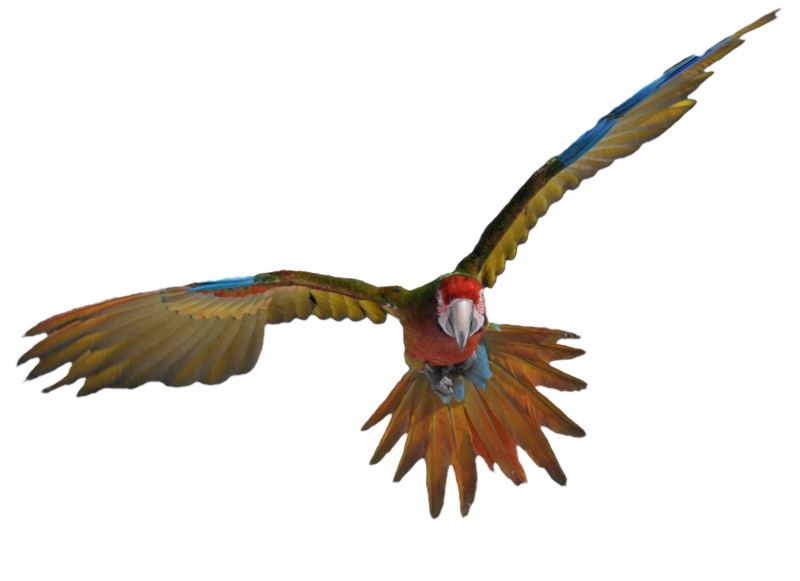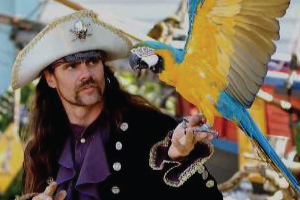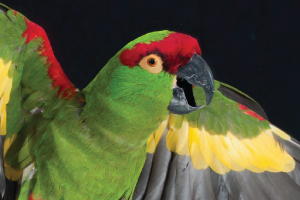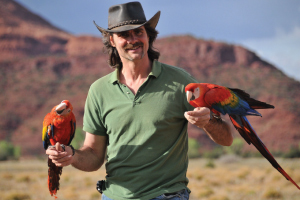
Basic Flight Training
Written By Chris Biro, Copyright 2008
Success training parrots to fly out doors depends largely on your ability to set the animal up to change its behavior. Before attempting to flight train a parrot outdoors I recommend you master basic training skills. There are several articles on this site about clicker training. I also recommend you watch this short video by Behavior Works.
For the safest, fastest and I think most fun way to reach the goal of having a fully flight trained bird, I highly recommend training a baby bird at the natural age of fledgling. I believe it is best, especially for a new trainer, to select the candidate that will offer the trainer (and trainee) the least degree of difficulty and thus the highest chances of success. No other selection criteria will be of as great an impact as is the age at which the bird is trained for flight. I personally like to start my time with the new flight student prior to it being weaned; if they are partially to mostly feathered and still hand feeding it gives us the time to adjust to each other prior to the actual flying starting. I personally think this time before actual training starts is very valuable both from a training stand point and from a very enjoyable experience stand point. Also I see behavior differences in the birds started and flown rigorously at the youngest age even when compared to baby birds that we took our time to get them flying outdoors. A few weeks seems to make a difference in the birds personality and attitude toward flying.
The basic steps are fairly simple. There are several “Tasks” you will be working on at the same time: 1) letting the bird develop all the flight skills it can while indoors; 2) learning a routine of flying back and forth to you from a perch on cue; 3) getting the bird comfortable being outdoors in the intended outdoor flying area; 4) developing a strong relationship between you and the bird.
1) Letting the bird develop all the flight skills it can while indoors is important because obviously the more skills it can master without the risk of getting lost, the less likely it will be to get lost once going outdoors where getting lost is added to the equation. Taking any bird outdoors that CAN fly and that is NOT trained is quite simply asking for disaster. Baby birds are FAR easier to train for flight but that does NOT mean that they cannot get lost at this stage. In the wild the first flights may be much longer than you and I could possibly keep up with and only other birds, like their parents, could follow on the wing. Their parents fly with them where they lead. We cannot. So we must take a different approach to this initial training. We start indoors and develop as many skills as we can before moving outdoors.
The bird will start out making ‘desperation flights’ from its cage or perch to get to places it REALLY wants to get to (I like to house them in a card board box on the top of a cage with play gym top – this functions as their base/nest). As its ability and confidence in doing these kinds of flights improves, it will soon start making ‘exploratory flights’. These are flights that let it go check things out and may include flights that circle back without actually landing. There is a notable difference in that the desperation flights are clearly motivated by a strong drive to get to something really important whereas the exploratory flights are far more casual. This shows me the bird has reached a comfort level with its flying in this indoor environment and that we are ready to start working on formal training sessions. I am also working to see solid foods being eaten at this time. These are the two issues I look for to start my formal clicker training sessions.
I start with targeting the end of a target stick. The bird learns to touch the target stick; then move or turn its head to reach over to touch the target stick; then walk across the cage top to touch the target stick; then walk across the cage top and step onto my arm to touch the target stick; then walk across the cage top and step onto my arm and walk down my arm to touch the target stick; then hop from cage top across 2 inch gap to get to my arm to walk down my arm to touch the target stick; then increase the distance in small steps until the bird is flying across several feet to come land on my arm to touch the target stick. At about this point I am adding a recall cue and fading out the target stick. We then work on flying back to the cage top to eat the goody. This quickly becomes a game of “fly to me and return to the perch”. We then fully develop this game into fly from any place in the room to me and fly back to the perch; fly to me even when I am standing just inside a doorway (slightly visible to the bird), then fly to me inside that same door but when the bird cannot see me, and fly back to the perch (this is developing Object Permanence – ability to track moving objects after they move out of sight); find me in different rooms is fun also – this develops problem solving skills. The goal here is to develop the birds skills to the maximum level achievable while still working in this indoor setting. At some point you will probably start to see the bird doing some “jinking” or Predator Evasion Maneuvers – rapid twisting and dodging while flying. This to me is a sign that the bird has reached a basic level of skill comparable to the size of the space and is expanding those flights skills on its own. If the other 3 Tasks are accomplished also then at this point I am ready to start the same training process over outdoors.
2) Learning a routine of flying back and forth to you from a perch on cue is to me VERY important because this helps them know what they are expected to do when we do venture outdoors. I believe it is important for them to have a task, not just have the freedom to fly in any direction as far as they want. I obviously do NOT want them to fly in any direction as far as they want so to prevent this I like to assign them a task that they not only understand but have already demonstrated that they are fully capable of doing. This gives me confidence and security in taking them outdoors and I suspect it gives them confidence and security during their first outdoor flights. This also makes this training process into a really fun experience that the two of you share. I also believe that such training is important to this process because it helps them develop critical thinking processes by not only stimulating their physical growth but also stimulating their mental processes. This game also helps develop Task #4.
3) Getting the bird comfortable being outdoors in the intended outdoor flying area is critical before attempting to fly the bird outdoors. For such a young bird this step is very easy. The bird simply is placed in a cage outdoors in the area you are expecting to do your outdoor training. The main idea here is simple: the bird needs to be calm and comfortable in the environment it is flown in. If the bird is NOT comfortable or calm in that environment, it will act differently than what you may be expecting. For those first outdoor flights you want as few NEW or different stimuli involved as possible. As the bird does its first outdoor flights of “fly from perch to me and back again”, as much as possible, everything should be the same as what the bird is already used to. If the bird is fearful or apprehensive of anything, you will not be able to accurately predict what it will do and that is a good way to lose an inexperienced bird. Outdoors has a lot of different elements from your home and many of those elements can be scary when first encountered. Just having the bird outdoors in a cage for some hours for a few days can help the bird become comfortable with what is normal outdoors. They quickly learn what normal “stuff” is not to be worried about. That means that when you are ready to do those first outdoor flights, the bird can be focused on you and your “games” and not focused on a thousand other distractions.
4) Developing a strong relationship between you and the bird is central to all of the above. I find that having a close bond with the bird helps me better do formal training sessions and helps the bird be more calm in new environments we work in. Freeflight training is about developing a set of skills in your pet bird that will enhance the experience you and your bird have with each other. Though birds of any age can develop a bond with a human, none do so as easily, completely and quickly as does a baby parrot at about the age of fledging. And at this age nature has their bodies and brains primed to learn flight skills without getting lost from “mom”. So IF you establish yourself as the “mom” character then the bird is especially focused on staying near you as it learns to fly. Obviously this is a very useful tool for flight training parrots to fly outdoors. This also means that the outdoor flight training needs to happen during the time frame that nature would have the baby bird being ultra attentive to the location of “mom”. Delay flight training outdoors too long and this advantage could disappear. Also failing to develop a good bond between the young bird and the trainer could cause this advantage to not be present. I personally very much enjoy the close bond with my birds so that aspect is enough for me to want to develop a close bond with the young bird. I enjoy the entire process of watching them grow from ball of pin feathers to mature fully skilled flyers. In watching such an amazing process develop it would be hard for any reasonably caring person not to develop such a close bond with such a wonderful little creature. I believe it is not only fun for them but I think it also is very healthy for them to from day one have a good relationship with the trainer. I have raised and trained many baby parrots and they all have turned out to be fabulous flyers and well socialized healthy pets.
“Did you spend a long time indoors on recall?”
This process normally does not take very long to train with a baby. Obee (Patagonian) I started flying indoors and about two weeks later was flying outdoors at a fair. The larger macaws can take longer to develop and I have taken them outdoors within a month but have also delayed three months or so.
“Did you train for excellent flight skills (flying down, difficult landing, etc.) before going outside?”
With a baby bird I do not. I train fly back and forth to a perch. That is my main goal. They will start to expand their own skills within the available space. And outdoors they learn to fly down VERY quickly, as in within a few minutes if at the right age.
“Did you fly the baby in the aviary before outside?”
If you have an aviary, by all means use it for training. The main idea is to develop as many of their basic flight skills to the maximum level before taking them outdoors. So yes, I use the aviary now that I have one. In the old days I did not do much training in the outdoor cages simply because they were no larger than my living room. But as described above, I do want them spending several days worth of time in a cage outdoors, getting comfortable in the outdoor environment.
“Did you train a lot of other responses (tricks) before going outside?”
Just the main targeting, recall, and recall game. With a baby bird at this age, they are normally ready to start with this initial indoor flights before they have all their mental skills developed. Object permanence must be learned, as does general cause and affect relationships. So training targeting is all I need to get them working on recall. I will work on other “trick” behaviors either as a side issue for our non flying time together during this process or at a later date. I do not find it critical to train a variety of tricks before flight training a baby bird to fly. But with an adult bird starting this process I most certainly would work on several other tricks prior to doing any flight training to help better establish how this learning process works, including stimulus control issues.
“When do you allow the 2 birds to fly together (what criteria need to be met first)?”
Training a new bird to fly with the other(s) is pretty simple. The first thing is to train each bird to fly solo. If they are hanging out and flying together indoors, then moving outdoors will not be easier. If they are not close buddies then facing a common threat will often help genet the flocking mentality. We often see more flocking behavior after a chase by a crow, seagull or hawk. Babies do seem to be well accepted by adults, the younger the adult the more easily accepted the babies it seems. You do need to watch the adult to make sure it truly is accepting the baby. I have had several young adult parrots immediately want to help feed the baby. I should note though that they do not have to be buddies to fly together. I don’t think Janet’s Lyndall and Chloe were particularly friendly before their flyoff. But if they will be helping each other any, it helps if they are close buddies. For flying together all they seem to need to be contact calling each other when separated.
As to how to allow them to fly together outdoors, I have done this several different ways. I have taken a more slow approach where I trained each bird to fly outdoors myself and then later let them fly outdoors together with another trained bird. I have also taken an experienced outdoor flyer (to act as mentor) and a baby flyer (who had mastered indoor skills and was ready for outdoor training) who were close friends indoors and then released them out the front door. This later method resulted in an initial very long first flight that was a bit stressful at first but within 20 minutes or so the baby looked like an old pro. Red Claw (Mitred) trained Frisbee, Flash, and Kiwi (Mitreds) this way. All I had to do was continue the recall training the same as I had been doing indoors, Red Claw did all the skill expansion. That first flight lasted longer than I had ever seen any of them fly in one flight. That is when I came to believe that nature has them primed for full physical fitness at fledging age.
So to answer your question, the only actual criteria issues I can think of are contact calling between the two and working on one new bird at a time. If you are going to rely on the older to help with some of training then the two should be well bonded. Flying together in formation is a whole set of skills that will develop with practice but there is not much we as trainers contribute to that process other than giving them the time to practice. Introducing several new birds at once is not recommended. Once flying in a flock there is no actual leader so any of the new birds can pull the flock in any direction, including out of the area the others are familiar with. It is best to introduce one new flyer to the flock at a time and allow that new bird to become highly proficient before adding the next new bird. If you have 4 new baby birds, take them all to the flying location but only let one out at time. There should never to two new flyers out at the same time. Fly the first new flyer for a while then put it back into a carrier and let the next new flyer out. Repeat until each has had some flying time. Do this several days before attempting to fly two of the new birds at the same time. Your goal is that the new bird learns what is expected when going out flying like this before you complicate the rules by adding another bird who does not know the rules yet.
Parrots: more than pets, friends for life.Chris Biro
Resources and More
The Pirate's Parrot Show
An educationally based pirate-themed parrot show performing at state and county fairs since 1991. The Pirate’s Parrot Show is a Fun, Educational, and Interactive experience for all ages and cultures.
Bird Recovery International
One in every eight bird species in the world today is in danger of extinction and these numbers are increasing! Find out how this non-profit organization started by Chris Biro can help save and protect parrots and other birds.
Podcasts with Chris Biro
An Alternate Perspective – Enjoy these audio Podcasts of Chris with guests discussing the nature of training flighted birds. The discussions are intended to be loosely structured around a general topic.
Email Us
chris@libertywings.com
Call Us
(206) 618-2610
Contact Us
By Using the Contact Form




Article Comments